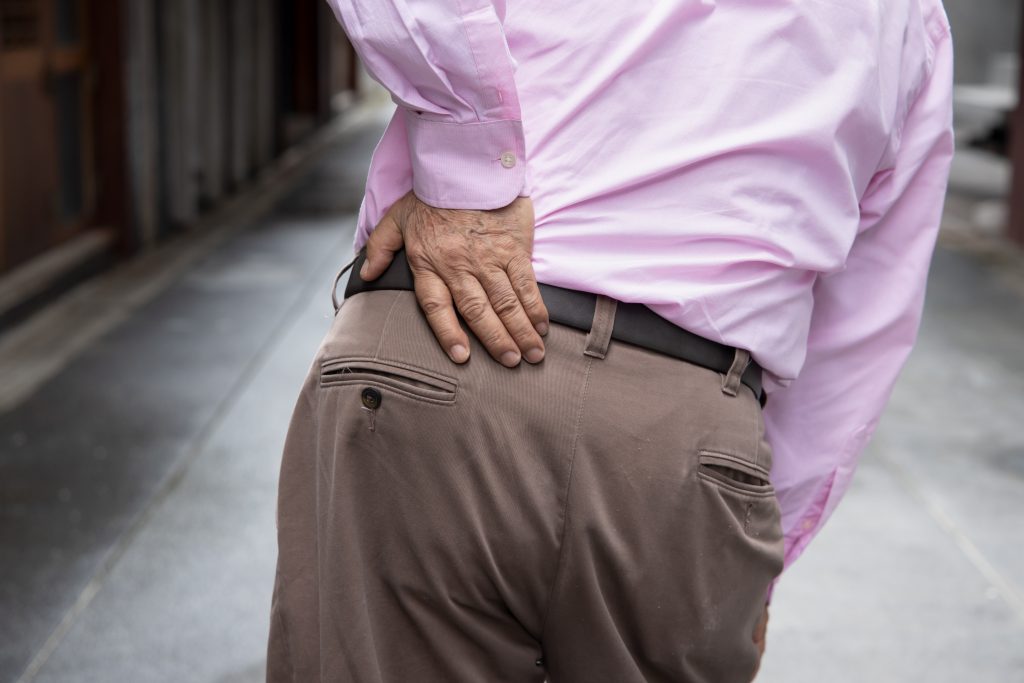Hip pain can originate from a variety of sources, including tense, strained, or overused hip muscles, or even issues within the hip joint itself. It may also arise from injuries, be referred from the back, or be associated with an individual’s movement patterns, posture, and hip utilization.
A frequent source of hip pain is osteoarthritis or the gradual wear and tear of the hip joint. Osteopaths can assist in managing the resulting stiffness by evaluating hip movement, enhancing muscle strength and flexibility, employing gentle muscle massage techniques, and applying stretches to alleviate tension and enhance joint mobility. Additionally, they address secondary issues like backache.

Osteoarthritis so called “wear-and-tear-arthritis” is the most common form of joint arthritis and cause of disability in the UK. It can occur in any joint in the body, bust most often develops in weight-bearing joint such as hip and knee.
In non-pharmacological management suggested by NICE guideline, manipulation and stretching should be considered as an adjunct to core treatments, particularly for osteoarthritis of the hip.
The most common symptom of hip osteoarthritis is pain and stiffness. Other symptoms may include:
Since osteoarthritis gradually aggravates over time, the sooner you start the treatment, the more likely it is that you can lessen its impact on your life. There is no cure for osteoarthritis however there are number of treatments to help relieve the symptoms:
Your doctor may recommend surgery if the pain causes disability and is not relieved with non-surgical treatments. Arthroplasty or joint replacement is the most common hip and knee replacement surgery in which your surgeon will remove the affected joint and replace it with an artificial (prosthesis) joint.
It occurs when bony spurs develop around the femoral head (Ball of the hip) pinches against the acetabulum (cup of the hip). This bony overgrowth prevents the hip joint from moving smoothly during activity, leading to pain (in groin area), stiffness and osteoarthritis.
There are two main causes of FAI:
Hip impingement treatment include:
In certain cases where these treatments have not solved the problem, surgery can be considered where the aim is to alter the bony abnormalities via arthroscopy.
it is a condition in which feel snapping sensation or hear a popping sound in your hip when you walk, get up or swing your legs. In most cases, snapping hip is the result of tightness in the muscles and tendons surrounding the hip, causing them to move over a bony protrusion in your hip. Dancers and young athletes are more vulnerable to this condition.
Some of the symptoms of snapping hip syndrome may include:
Unless snapping hip syndrome is painful or lead to difficulty in doing sports or other activities, most people do not see a doctor.
According to NICE guideline, if the conservative options fail to provide improvement in the symptoms, physical therapy with emphasis on stretching, strengthening can help. Sometimes, your doctor may recommend corticosteroid injection depending on the cause of the snapping hip. In rare cases, doctors may consider surgery.
The Iliopsoas muscle is a strong muscle that plays important role in standing or sitting posture and during walking and turning. Bursa is a slippery sac of fluid located beneath this muscle to provide a cushion and reducing friction between the bone and the muscle. Iliopsoas bursitis is an inflammation of the bursa which make it difficult to walk and exercise. It is mainly caused by certain type of arthritis, acute trauma, and overuse injury. It is usually seen in individuals participating in rowing, uphill running, and strength training.
Common symptoms of iliopsoas bursitis include:
You can book an appointment by clicking on the button below.
© 2023 Created with LOVE by Harmonix Digital
1 Sutton Oak Corner, Streetly,
Sutton Coldfield, B74 2DH